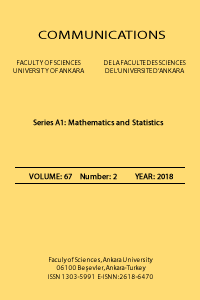THE QUENCHING BEHAVIOR OF A PARABOLIC SYSTEM
Parabolic system, boundary condition, quenching, quenching point, quenching time maximum principles,
___
- C.Y. Chan, Recent advances in quenching phenomena, Proc. Dynam. Sys. Appl. 2, 1996, pp. 113.
- C.Y. Chan, New results in quenching, Proc. of the First World Congress of Nonlinear Ana- lysts, Walter de Gruyter, New York, 1996, pp. 427-434.
- C.Y. Chan and N. Ozalp, Singular reactions-diğusion mixed boundary value quenching prob- lems, Dynamical Systems and Applications, World Sci. Ser. Appl. Anal., 4, World Sci. Publ., River Edge, NJ, (1995) 127-137.
- C.Y. Chan and S.I. Yuen, Parabolic problems with nonlinear absorptions and releases at the boundaries, Appl. Math. Comput.,121 (2001) 203-209.
- M. Chipot, M. Fila and P. Quittner, Stationary solutions, blow up and convergence to sta- tionary solutions for semilinear parabolic equations with nonlinear boundary conditions, Acta Mathematica Universitatis Comenianae— New Series, Vol. 60, No. 1 (1991), s. 35–103.
- K. Deng and M. Xu, Quenching for a nonlinear diğusion equation with a singular boundary condition, Z. Angew. Math. Phys. 50 (1999) 574-584.
- N. E. Dyakevich, Existence, uniqueness, and quenching properties of solutions for degenerate semilinear parabolic problems with second boundary conditions, J. Math. Anal. Appl. 338 (2008), 892-901.
- M. Fila and H.A. Levine, Quenching on the boundary, Nonlinear Anal. 21 (1993) 795–802.
- S.-C. Fu and J.-S. Guo, Blow up for a semilinear reaction-diğusion system coupled in both equations and boundary conditions, J. Math. Anal. Appl. 276 (2002) 458-475.
- R. Ji and S. Zheng, Quenching behavior of solutions to heat equations with coupled boundary singularities, Applied Mathematics and Computation 206 (2008) 403–412.
- H. Kawarada, On solutions of initial-boundary problem for ut= uxx+ 1=(1 u), Publ. Res. Inst. Math. Sci. 10 (1975) 729-736.
- L. Ke and S.Ning, Quenching for degenerate parabolic equations, Nonlinear Anal. 34 (1998) 1135.
- C.M. Kirk and C.A. Roberts, A review of quenching results in the context of nonlinear volterra equations, Dynamics of Discrete and Impulsive Systems. Series A: Mathematical Analysis, (2003) 343-356.
- C. Mu, Shouming Zhou and D. Liu, Quenching for a reaction diğusion system with logarithmic singularity, Nonlinear Analysis 71 (2009) 5599-5605
- W. E. Olmstead and C. A. Roberts, Critical speed for quenching, Advances in quenching, Dynamics of Discrete and Impulsive Systems. Series A: Mathematical Analysis, 8 (2001), no. , 77-88.
- A. De Pablo, F. Quiros and J. D. Rossi, Nonsimultaneous Quenching, Applied Mathematics Letters 15 (2002) 265-269.
- M.H. Protter and H.F. Weinberger, Maximum Principles in Diğerential Equations, Springer, New York, 1984.
- R. Xu, C. Jin, T. Yu and Y. Liu, On quenching for some parabolic problems with combined power-type nonlinearities, Nonlinear Analysis Real World Applications, Vol. 13, 1 (2012) 339.
- S. Zheng and W. Wang, Non-simultaneous versus simultaneous quenching in a coupled non- linear parabolic system, Nonlinear Analysis 69 (2008) 2274–2285.
- J. Zhou, Y. He and C. Mu, Incomplete quenching of heat equations with absorption, Ap- plicable Analysis, Vol. 87, No. 5, May 2008, 523–529.
- Current address : Department of Computer Engineering, Karabuk University, Balıklarkayası Mevkii, 78050, TURKEY.
- URL: http://communications.science.ankara.edu.tr/index.php?series=A1 E-mail address : bselcuk@karabuk.edu.tr
- ISSN: 1303-5991
- Yayın Aralığı: Yılda 4 Sayı
- Başlangıç: 1948
- Yayıncı: Ankara Üniversitesi
Gültaç EROĞLU İNAN, Aysen APAYDIN
Sevda SAĞIROĞLU, Erdal GÜNER, Eda KOÇYİĞİT
WATADAíS FUZZY PORTFOLIO SELECTION MODEL AND ITS APPLICATION
